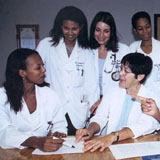Biography: Dr. Theresa Loya

It is true to say that most women are idealists, we are natural healers, and we find it offensive to witness human suffering. That was the impetus for my seeking a career in medicine. While in North Africa in the Peace Corps, helping to establish a lab in the casbah of Rabat, Morocco, then working in a tuberculosis sanitarium in Meknes, Morocco, I found the strength and the resolve to become a physician. With the hope [that] some day, in some way I could help alleviate human suffering.
Theresa Loya was the first in her family to attend college. Today, with board certifications both in anatomic and clinical pathology and in internal medicine, she seeks to help the poor and underserved with cancer prevention strategies as well as early detection and intervention for those who already have the disease. Dr. Loya served in the Peace Corps in North Africa before assuming her present positions as assistant professor of pathology at Charles R. Drew University of Medicine and Science and assistant clinical professor of pathology at the University of California, Los Angeles. As an undergraduate at the University of California at Berkeley, she helped establish La Clínica de la Raza in East Oakland, and she spent more than twenty years working to improve the health status of farm workers in Guatemala.
Dr. Loya earned both her B.A. and her Master of Public Health degree from the University of California at Berkeley, and her M.D. from the University of California at Davis. She also had a one-year fellowship in Anatomic Pathology at the University of Southern California.
Dr. Loya completed residencies in anatomic and clinical pathology and in internal medicine, at the University of California at Irvine. She has been a member of the Drew University Medical School Admissions Committee, Academic Senate, International Health Institute, and Educational Policy & Curriculum Committee. She also has served as the university representative for Hispanic Serving Health Profession Schools.
At the Martin Luther King/Charles R. Drew Medical Center Dr. Loya has conducted two studies to determine baseline statistics for women with cervical dysplasia/cervical cancer and breast cancer. The initial results of the breast cancer study have revealed that 69 percent of Hispanic women presented with tumors between 2.1 to 5 centimeters, compared to 44.6 percent nationally. In addition, 92 percent of Hispanic women presented with lymph node involvement by metastatic tumor compared to 42 percent nationally. And finally, of Hispanic women at their facility, 62 percent of Hispanic women presented with stage 2 disease and 23 percent presented with stage 3 disease, compared to 35 percent and 4 percent at a national level.
How do I make a difference?
Over the years, I have neither achieved great fame nor recognition but I have experienced great personal satisfaction knowing that I have tried my best to keep my promise to my fellow man. As an undergraduate at Cal Berkeley I helped to establish La Clinica De La Raza in East Oakland, which is still in operation today. I have helped to improve the health and educational status of farm workers in the highlands of Guatemala. And, most recently, while working as a pathologist, at a safety net hospital in South Central Los Angeles I have gathered, with the help of dedicated volunteer medical students, baseline data on cervical dysplasia, cervical cancer and breast cancer in underserved, poor Latinas and African-American women. Mortality rates from these cancers are higher in underserved women. We will never attain our goal of "Healthy People 2010"—a set of national health objectives that can be used by many different people, States, communities, professional organizations, and others to help them develop programs to improve health—and long-term survival from cervical and breast cancer will never be achieved for underserved women until prevention and access to quality health care which is culturally and linguistically appropriate is made available to all in our society.




